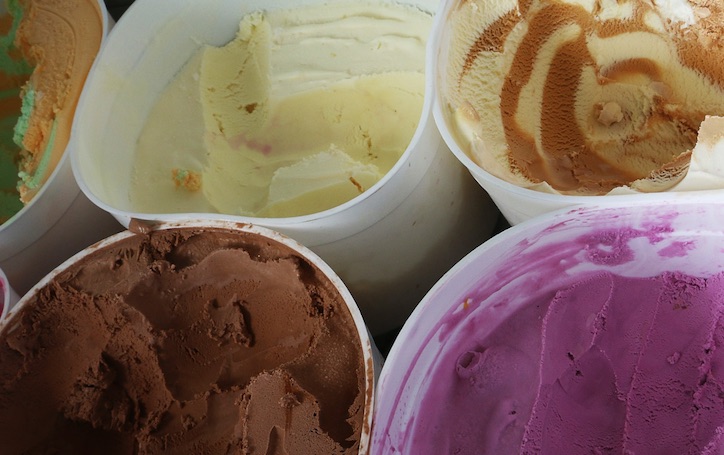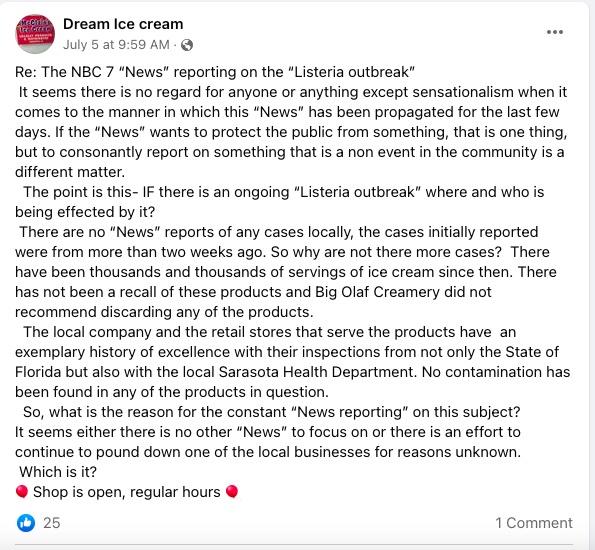For Big Olaf, the break-ups came quickly but not all at once. And not all of them quietly.
In the two and half weeks since Big Olaf ice cream was linked to a deadly Listeria outbreak, licensed shops throughout Florida started switching to new suppliers. One owner has permanently changed the names of the two stores she operates.
Although Listeria isn’t as common as other foodborne pathogens. It is the most deadly. And it targets pregnant women, who can suffer a miscarriage or stillbirth if they develop an infection.
“Five of the patients in this outbreak are women who contracted listeriosis while they were pregnant,” said Eric Hageman, a Listeria lawyer, and Food Poisoning Bulletin Publisher. Hageman has extensive experience with Listeria lawsuits including one filed on behalf of a 31-year-old man who suffered permanent brain damage after eating ice cream contaminated with Listeria in 2013.
Big Olaf Listeria Outbreak
On July 2, the Centers for Disease Control and Prevention (CDC) announced that epidemiological evidence had identified Big Olaf ice cream as the source of a 10-state Listeria outbreak that included 23 illnesses, one death, and one miscarriage.
All of the patients either live in or visited Florida before they became ill. Health officials used whole genome sequencing on the Listeria strains cultured from each patient and determined that they were highly related. This means the patients likely all got sick from the same food. Big Olaf ice cream is sold at multiple locations in Florida and one location in Ohio.
At the time of the July 2 announcement, health officials had interviewed 17 of the outbreak patients about the foods they had eaten in the month before they developed Listeria symptoms. Fourteen said they had eaten ice cream. Six remembered eating Big Olaf ice cream or eating ice cream at locations that serve Big Olaf.
Since then, results of tests conducted by the Florida Department of Agriculture and Consumer Services have revealed that 10 environmental samples from the Big Olaf production facility and 16 different flavors of Big Olaf ice cream tested positive for Listeria, Erin Moffet, a department spokesperson told Food Poisoning Bulletin.
But on July 2, there was epidemiological evidence linking Big Olaf Ice cream to the outbreak, and the companies that make and serve the ice cream had to choose their best path forward.
Big Olaf’s Response
For Big Olaf, that initial path included calling the epidemiological evidence “speculative,” and declining to issue a recall offering instead to contact vendors and recommend that they refrain from selling the product.
On July 3, Rosie Peachy, a Big Olaf representative said: “For now it is only speculation as it is an ongoing investigation, our brand has not been confirmed to be linked to these cases, I am not sure why only Big Olaf is being mentioned and targeted. The original report we got from the Florida Department of Health on Friday, July 1st, was that there are 23 cases reported, the first one reported was January 2022.[sic] 6 out of the 23 patients mentioned having consumed Big Olaf ice cream, but nothing has been proven. We have been cooperating with the Florida Department of Health, FDACS, and the FDA as soon as we were informed about the situation. We have been transparent and have answered all their questions and provided them with all the information requested from us, as the health and well-being of the public is our first priority.”

The Response from Stores
The response of many of the licensed stores has been chronicled by the Sarasota Herald-Tribune. According to the paper, the Venice location now sells Hershey’s ice cream and the Pinecraft store is serving ice cream made by Chocolate Shoppe. The St. Armands Circle and Siesta Key locations continued to sell Big Olaf ice cream through July 3. St. Armands then shut down, conducted a rigorous cleaning process, and reopened on July 7 serving Yoders ice cream, the paper reported.
According to the Siesta Sand, the Siesta Key location, known as Big Olaf Creamery for 40 years, closed down on July 3 for a deep cleaning and reopened on July 8 nameless. That location is also now serving Yoders. A spokesperson told the paper that if they don’t sell Big Olaf ice cream, they can’t use any of the branding. At the time of that report, the store had no signage and employees were answering the phone with a simple “hello.”
Not all of the Big Olaf locations quietly switched brands. On July 5, Eszter Bazso, who owns two locations, Cattlemen Road and South Tamiami Trail, posted the following message on Facebook:

Eight days later, another Facebook post announced that after a brief closure the two stores would be reopening on July 14 with new names. And they would be serving McClain’s ice cream.
Returning to the July 5 Facebook post briefly, there are a couple of things worth noting. First, the post notes that “There has not been a recall of these products and Big Olaf Creamery did not recommend discarding any of the products.” That’s interesting because, according to the CDC, the company told the agency on July 1 that it would not issue a recall but had already begun contacting vendors. Why would this process take more than four days?
Next, the post states that there are no news reports of local cases. That’s just false. July 2 was the first day any agency had identified the source of this outbreak and dozens if not hundreds of outlets, including this one, reported that 12 of the 23 patients lived in Florida and 10 others had visited the state before becoming ill. On July 3, Ms, Bazso even reposted the Big Olaf statement from July 3 that said six of the 23 patients specifically mentioned eating Big Olaf ice cream before they became ill. Again, aside from one location in Ohio, Big Olaf ice cream is only sold in Florida.
Finally, the post says that the cases initially reported happened more than two weeks ago and wondered why more cases hadn’t been reported as the ice cream had not been recalled. Symptoms of a Listeria infection can take as long as 70 days to develop. Before a case can appear in a CDC report, the individual has to get sick and see a doctor who then conducts tests for food poisoning. If the test is positive for a reportable disease like listeriosis, the state health department needs to be notified. Then genetic testing is done and the genetic fingerprint is uploaded to a national database where the CDC searches for fingerprints that are closely related indicating an outbreak. So, there is a bit of a lag in reporting. The patients in this outbreak first reported symptoms on dates ranging from January 24, 2021, through June 12, 2022.
And even though Big Olaf didn’t issue a recall, on July 2, the CDC warned consumers not to eat and establishments not to serve Big Olaf ice cream. That information was in all of those overlooked news reports.
Big Olaf Ice Cream Recall
On July 13, the same day that the Florida agriculture department announced all those positive Listera tests, and the day Eszter Bazso announced the name change of her stores, Big Olaf issued a recall for all of its ice cream. The recall includes all flavors and lot codes with expiration dates through 6/30/2022. The recalled ice cream was sold in plastic pint, half-gallon, and 2.5-gallon containers. Consumers who may have this ice cream at home in their freezers should not eat it.

If you have been sickened with a Listeria infection, please contact our experienced attorneys for help with a possible lawsuit at 1-888-377-8900 or 612-338-0202.




